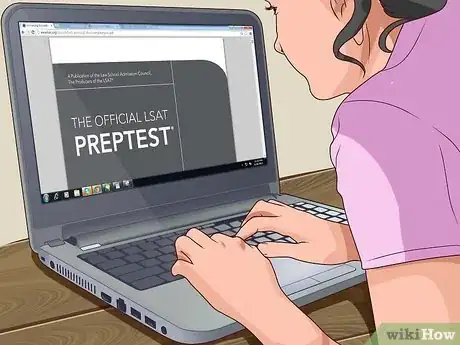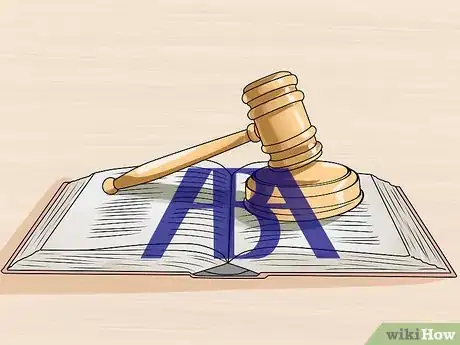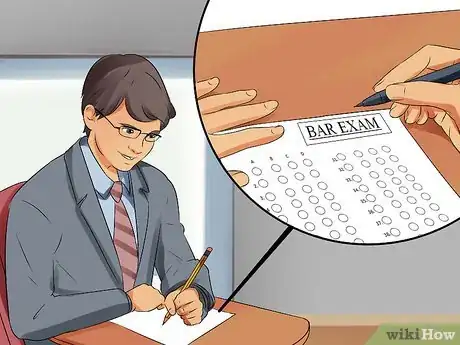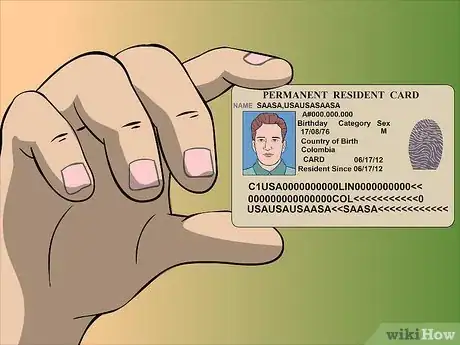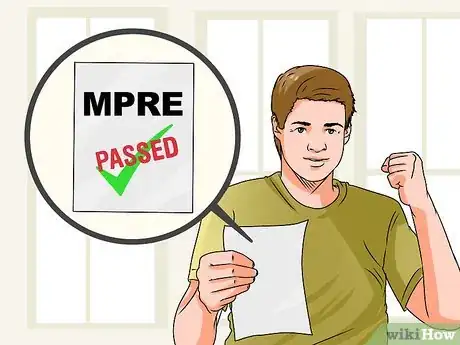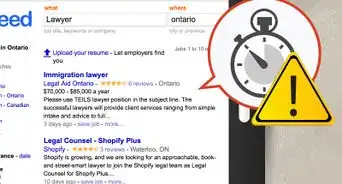This article was co-authored by Clinton M. Sandvick, JD, PhD. Clinton M. Sandvick worked as a civil litigator in California for over 7 years. He received his JD from the University of Wisconsin-Madison in 1998 and his PhD in American History from the University of Oregon in 2013.
There are 27 references cited in this article, which can be found at the bottom of the page.
This article has been viewed 49,074 times.
In Texas, the practice of law is defined as preparation of legal documents, giving legal advice, and appearing in court on behalf of a client. [1] In order to practice law in Texas, you must be a licensed attorney admitted to the state bar. The licensing procedure is multi-stage and can begin on the first day of college.
Steps
Preparing for Your Legal Career
-
1Choose an undergraduate course of study. Law school is an advanced graduate degree. In order to qualify for application, you must first complete a four-year bachelor's degree from a recognized college. The American Bar Association (ABA) doesn't recommend or require any specific course of study. A diverse liberal arts degree encompassing history, literature, philosophy, and political science will provide solid groundwork for your legal education. [2]
- The one exception to the undergraduate degree requirement is if you want to practice patent law. That requires a degree in hard science such as engineering, nursing, biology, or chemistry. [3]
- You are not required to get your undergraduate degree in Texas. Your degree may be from any college in the United States that is recognized by the U.S. Dept. of Education.[4] Degrees from schools in other countries may suffice, but if your degree is from outside the United States, your transcript may be reviewed by an organization such as the Law School Advisory Council for equivalence to a domestic school.[5]
- Undergraduate grade point average is a critical factor in admission to law school. Study widely in diverse subjects that you enjoy and you believe you will succeed in. [6]
-
2Take the pre-entrance LSAT exam. The Law School Aptitude Test, better known as the LSAT, is a critical part of your law school admissions package. The LSAT is multiple choice, with five sections that you have 35 minutes each to complete. Your score will be drawn from four of the sections. [7]
- Reading comprehension tests your ability to read and analyze long passages of text. The questions will come from arts, humanities, and hard science. [8]
- The sections on analytical reasoning challenges test-takers in inference, deductive reasoning, and drawing relationships between statements. The classic analytical question starts out, "If A is taller than B, and C is taller than D..."[9]
- Logical reasoning does not require the study of logic. However, the questions will challenge you to identify parts of an argument and draw conclusions based on a presentation of related facts. [10]
- There is also a writing sample that is not included in your LSAT score. However, it is provided to the schools you apply to. [11]
- The LSAT is offered several times a year in different locations in the US and internationally. There are test dates to accommodate religious holidays and Sabbath observances. [12]
- There are free test preparation materials, as well as sample tests for purchase. At a minimum, you should get comfortable with the format of the questions and working under the time limits. [13] Commercial materials are not required, but may be helpful.
Completing Your Legal Education
-
1Attend an ABA approved law school. There are nine law schools in Texas. However, you do not have to attend law school in Texas to practice there. A Juris Doctor degree, or equivalent, from one of the 200+ law schools approved by the American Bar Association (ABA) will meet the requirements to sit for the bar exam in Texas.[14]
- Attending an ABA-approved law school offers many benefits. The school has shown that it meets a high level of professional standards regarding faculty and facilities, all states will allow you to sit for the bar exam, and have generally higher bar passage rates. [15]
- Some states, most notably California, will allow a graduate of a law school not approved by the ABA to take the bar exam and be licensed to practice.[16] Check with the licensing authority of the state you are considering before committing to attend a law school not approved by the ABA.
-
2Complete all requirements for graduation. Law schools vary slightly in degree requirements, but to meet the ABA standards,[17] schools will require you to complete a prescribed field of study. Requirements typically include classes in contracts, torts, property, constitutional law, civil procedure, and legal research. Most schools require that you graduate with a minimum 2.0 grade point average in your legal coursework.
-
3Enroll in and complete a course in professional responsibility. The ABA requires that law schools offer instruction in the ethics and responsibilities of the legal profession. A typical course looks at the history and development of legal ethics and how to apply these rules to the practice of law.
Taking the Texas Bar Exam
-
1
-
2Decide if you will take the laptop computer version of the test. Texas offers the ability to take the Multistate Performance Test (MPT) and the Texas Essay Exam on your laptop. You must register separately for this procedure, meet the hardware requirements, and pay the separate registration fee. [20]
- Laptop test-takers must bring blue or black pens to take the hand-written exam in the event of a computer failure.
- Laptop test-takers must bring a power and/or extension cord at least eight feet long.
- Your laptop cannot have CDs, DVDs, USB drives, dongles, or any cell phone or wifi device. You cannot bring your laptop in a case, cover, or computer bag.
-
3Sit for the bar exam. The Texas bar exam is a three-day test offered twice each year, usually in February and July. Locations are determined by the state board of bar examiners. It consists of the MPT (paper with black ink or laptop), the Procedure & Evidence section (P&E) (paper with black ink or laptop), the Multi-State Bar Exam (MBE), a multiple-choice test taken by pencil, and the essay portion (paper with black ink or laptop.)
- You will need photo identification and your admission ticket. Do not bring a watch, timer, cell phones, smart watches, or any other electronic devices, except your approved laptop. Failure to comply may result in being ejected from the exam site.
-
4Achieve a passing score on the bar exam. There are 1000 possible points divided between the MPT (10%), the P&E (10%), the MBE (40%), and the essay exam (40%.) To pass, you must receive a minimum of 675 points. Results are usually available approximately 10 weeks after the exam date. Results are posted the the Board of Law Examiners' website, by first class mail, and physically posted at in-state law schools.
Applying to be Licensed to Practice Law
-
1Meet the Texas age and citizenship requirements. If you want to be licensed to practice law in Texas, you must be at least 18 years old. You must also be able to prove that you are a U.S. citizen or resident alien.
-
2Demonstrate good moral character and fitness. This requirement is satisfied by a thorough background and reference check. You will complete forms disclosing previous addresses, criminal records, treatment for mental illness or substance abuse, and releases of your tax records and credit scores.[23]
- If you have a criminal record or history of mental illness or drug abuse, the application will allow you to submit an explanation. Be honest and concentrate on the efforts you have made to improve yourself in the years following the proceeding.
-
3Submit a set of fingerprints for examination by the FBI. Texas residents may submit their fingerprints via a traditional paper "ten-card" or electronically through the Dept. of Public Safety. Contact your local police or sheriff's office to arrange electronic submission of your fingerprints. If you live outside of the state, you will be sent a paper card that you must complete, usually at your local sheriff's department, and submit within 30 days.
-
4Pay the required application and licensing fees. Your fees will be addressed to the clerk of the Supreme Court of Texas and the State Bar of Texas. Your primary county of practice may also require that you enroll in the local bar association. Expect total fees to be between $300 and $500. [24]
-
5Achieve a passing score on the Professional Ethics examination. The Multi-State Professional Responsibility (MPRE) exam is required for admission to the Texas bar. The MPRE is a two-hour, 60-question multiple choice exam offered three times each year. You will be tested on your knowledge of legal ethics and professional conduct. Texas requires that you pass with a score of 85 points.[25]
-
6
References
- ↑ http://codes.lp.findlaw.com/txstatutes/GV/2/G/81/G/81.101
- ↑ http://www.americanbar.org/groups/legal_education/resources/pre_law.html
- ↑ http://www.ipwatchdog.com/patent-bar-exam/patent-bar-qualifications/
- ↑ http://ope.ed.gov/accreditation/Search.aspx?6d6f64653d31267264743d332f372f3230313220333a35383a343020504d
- ↑ http://www.lsac.org/jd/applying-to-law-school/cas/internationally-educated-apps
- ↑ http://www.usnews.com/education/blogs/law-admissions-lowdown/2012/11/12/learn-the-5-deciding-factors-in-law-school-admissions
- ↑ http://www.lsac.org/jd/lsat/about-the-lsat
- ↑ http://www.lsac.org/jd/lsat/prep/reading-comprehension
- ↑ http://www.lsac.org/jd/lsat/prep/analytical-reasoning
- ↑ http://www.lsac.org/jd/lsat/prep/logical-reasoning
- ↑ http://www.lsac.org/jd/lsat/prep/writing-sample
- ↑ http://www.lsac.org/jd/lsat/test-dates-deadlines
- ↑ http://www.lsac.org/jd/lsat/preparing-for-the-lsat
- ↑ http://www.americanbar.org/groups/legal_education/resources/aba_approved_law_schools.html
- ↑ http://www.usnews.com/education/best-graduate-schools/top-law-schools/articles/2012/12/17/weigh-the-benefits-disadvantages-of-attending-a-non-aba-law-school
- ↑ http://lawschoolnumbers.com/application-prep/deciding-whether-to-attend-an-unaccredited-law-school
- ↑ http://www.americanbar.org/groups/legal_education/resources/standards.html
- ↑ http://www.ble.state.tx.us/FAQs/FAQs.htm
- ↑ http://www.ble.state.tx.us/FAQs/FAQs.htm
- ↑ http://www.ble.state.tx.us/FAQs/FAQs.htm
- ↑ http://www.investopedia.com/terms/r/residentalien.asp
- ↑ http://www.uscis.gov/greencard
- ↑ http://www.americanbar.org/publications/syllabus_home/volume_44_2012-2013/winter_2012-2013/professionalism_whatdoesittaketosatisfychracterandfitnessrequire.html
- ↑ https://www.texasbar.com/AM/Template.cfm?Section=New_Lawyer_Forms_and_Fees1&Template=/CM/ContentDisplay.cfm&ContentID=29060
- ↑ https://www.ncbex.org/exams/mpre/
- ↑ http://www.statutes.legis.state.tx.us/docs/GV/htm/GV.602.htm
- ↑ https://www.texasbar.com/AM/Template.cfm?Section=New_Lawyer_Forms_and_Fees1&Template=/CM/HTMLDisplay.cfm&ContentID=30304
- ↑ http://barreciprocity.com/texas-bar-reciprocity/
- ↑ file:///C:/Users/User/Downloads/attyadm_2014-05-14.pdf

